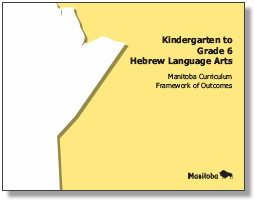Hebrew Program
March 2, 2022
The Hebrew Bilingual program at Brock Corydon School is the only Hebrew Heritage Language program in North America offered in a public school setting. The term "bilingual program" describes a partial immersion program in which instruction is provided in Hebrew. Other subject areas and cultural knowledge and skills are taught in both English and Hebrew, often through an integrated approach to instruction.
Commitment
The Brock Corydon Hebrew Bilingual program is committed to presenting a language and cultural experience that focuses on the exploration of language and culture from the perspective of history, diversity, and change.
Hebrew Language Arts
The Language Arts component of the Hebrew Bilingual program provides a framework of linguistic elements that students are to develop in the Hebrew language as well as expectations of proficiency at each grade level. Acquisition of these skills is achieved by implementing the most current Hebrew language programs developed in Israel and/or the Diaspora for use in a Diaspora classroom. Torah texts are utilized to enhance linguistic development by bridging ancient and modern Hebrew and by providing a linguistic connection between the past and the present. Hebrew language skills are further developed through the use of literature, poetry, songs, newspapers, magazines and computer programs in the target language.
Culture
The cultural component of the Hebrew Bilingual program provides students with opportunities to reflect on their own identity in a variety of contexts. Students are provided with the opportunity to explore and appreciate the diversity of holiday celebrations from an academic perspective. Presentation of the historical significance of the holidays is accomplished by encouraging students to examine the origins of each holiday and its significance and relationship to the land of Israel. Major holidays are celebrated communally.
In addition to exploring the origins and significance of the respective holidays, students receive instruction in the historical development of the Jewish people from biblical times to the present.
Students also receive instruction relating to the geography, historical development, politics and significance of the state of Israel to their lives. Current events are examined focusing on the effect of such events on Israel and the Diaspora.
The cultural component of the Hebrew Bilingual program is intended to be integrated with language learning as well as learning related to other subject areas and is a strong component of daily activities. This component is intended to be implemented in a purposeful, integrated manner.

Hebrew is one of the Semitic languages of the Afro-Asiatic language family. It is spoken by over 9 million persons in Israel and throughout the world. In Israel, it is spoken by the majority of the population and, along with Arabic, it is one of the two official languages. Although Hebrew is often associated with members of the Jewish faith, because Israel is a nation of immigrants, Hebrew is a second language for many of its speakers. Hebrew is also the mother tongue of Samaritans, though today only a few thousand Samaritans remain.
Hebrew language education has had a long presence in Manitoba. The origins of the Jewish community has been traced back to 1878. Subsequently, other Jewish families arrived through the United States, with a significant number arriving from Russia as a result of violence and persecution of Jews in1882. Jews were also part of the migration from other parts of Europe, seeking a new beginning and the opportunity to own their own farms. By the early 1960s, Winnipeg had the third-largest Jewish community in Canada.
Formal Hebrew language education began with the opening of the first Talmud Torah in 1902 when King Edward School opened its doors for the children of Jewish immigrants who had come to the new frontier of Winnipeg offering a school curriculum of Hebrew language, Talmud, Jewish literature and history. This was followed In 1907 by the Winnipeg Hebrew Free School – Talmud Torah. This was followed by opportunities for Yiddish language instruction with the establishment of the Peretz and Jewish Folk Schools in 1913.
In 1981, following the amendments to the Public School Act of 1979 that allowed languages other than French or English to be used for instruction in public schools, Hebrew-English bilingual programming was introduced in the Seven Oaks and Winnipeg School Divisions. Today, Manitoba is the only province that offera Hebrew bilingual programming in the public school system.
The term bilingual programming is used to describe a partial immersion program where both English and a second language (in this case, Hebrew) are languages of instruction. In Hebrew bilingual programming, Language Arts is taught using both languages of instruction. Other subjects are taught either in English or in Hebrew. Cultural knowledge, skills, and attitudes are often taught using an integrated approach.
Bilingual Programming
The development of the Kindergarten to Grade 6 Hebrew Language Arts: Manitoba Curriculum Framework of Outcomes (2008) was facilitated by the collaborative work that was completed earlier with Alberta and Saskatchewan through the Western and Northern Canadian Protocol for Collaboration in Basic Education in developing the 1999 Common Curriculum Framework for Bilingual Programming in International Languages (Kindergarten to Grade 12).
The Kindergarten to Grade 6 Hebrew Language Arts: Manitoba Curriculum Framework of Outcomes contains:
- an introduction describing the background, purpose, and development process
- a rationale and vision for Hebrew language arts education
- a definition and conceptual framework for Hebrew language arts in a bilingual school setting
- an orientation to the document
- a description of the organization of the document
- a description of the central concepts of the six General Learning Outcomes for Kindergarten to Grade 6
- Kindergarten to Grade 6 Specific Learning Outcomes
Language of Study or Basic Programming
Curriculum for Hebrew as a language of study is available in hard-copy format only. For information on the existing curriculum follow the contact information available on this page.
